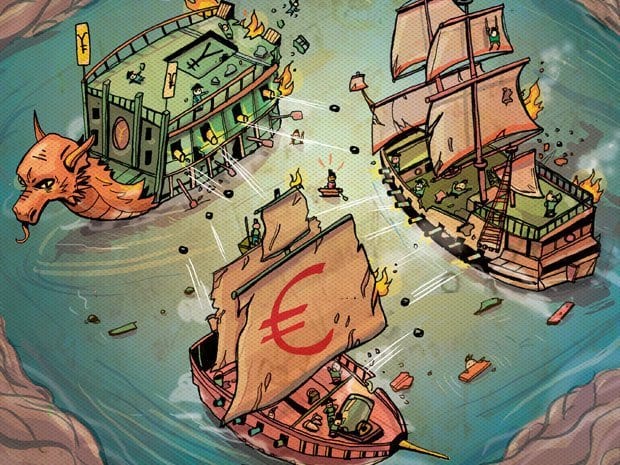
Dear Readers ,
When the world’s biggest money manager talks, every one listens.
PIMCO’s Bill Gross, manager of the world’s largest bond fund, just told the world he likes gold more than stocks or bonds. The world’s money managers followed suit.
The European Central Bank just announced a new and potentially unlimited bond buying plan. Prepare the blank checks; the United States already has.
The U.S. economy added 96,000 jobs in August, a disappointing result that could prompt an aggressive response from the Federal Reserve. Ammunition for another round of QE has been served.
If you didn’t believe me before, I seriously hope you do now: Gold will go a lot higher.
Last Sunday, in my letter, “America’s Gold Wiped Out,” I talked about the world’s current financial war: The Currency War
As a reminder:
A “currency war” is a fight between countries to achieve a lower exchange rate for their own currency. In other words, its competitive devaluation. In short, the cheaper your currency, the more money you attract from foreign entities; this leads to increased exports, growth, and job creation.
The dollar, the yuan, and the euro, are the three super power currencies leading the global currency war. The one on top will be the one that devalues its currency the fastest.
Currency is the heart of a nation; without it, it cannot survive. Its value is its Achilles heel. Collapse its value and everything goes with it.
Stocks, bonds, derivatives, and other investments are all linked through a complex network. If one sector is failing, another might be winning. For example, if stock and bonds are failing, one could turn to commodities to pick up the pieces.
However, all of these investment vehicles are priced in a nation’s currency. Destroy the currency and you destroy all of the markets within the nation. Destroy the markets, and you destroy the nation.
That is why currency is the target in any financial war.
Currency in a Financial War
And that is exactly why major battles are no longer fought with AK-74’s and tanks – these merely provide support.
In a controversial book published in 1999 by Col. Qiao Ling and Col. Wang Xiangsui of China’s People’s Liberation Army, they stated:
“In a world where “even nuclear warfare” will perhaps become obsolete military jargon, it is likely that a pasty-faced scholar wearing thick eyeglasses is better suited to be a modern solider than is a strong lowbrow with bulging biceps. We believe that before long, “financial warfare” will undoubtedly be an entry in the various types of dictionaries of official military jargon…financial war has become a “hyper strategic” weapon that is attracting the attention of the world. This is because financial war is easily manipulated and allows for concealed actions, and is also highly destructive.”
Everything around the world is interconnected. Bonds could be issued in Brazil, underwritten in London, and sold through New York. You could even package everything in the form of a derivative from one country and sell it to another; selling securities for cash, backed by nothing more than someone else’s performance.
That means any form of currency manipulation or attacks have serious repercussions around the world. And the two heavy weights of the world are in a full fledged battle against one another.
China vs. United States
While Europe is China’s largest trading partner, China’s main link with the global financial system is the U.S. government bond market.
China earns several hundred billion dollars every year from their trade surplus. This is a lot of money that needs to be invested, and few places can handle that type of investment without severely affecting market prices.
That’s why the Chinese have turned their surpluses into the one place that can handle the size of investments China needs to make – the U.S. government bond market.
China’s foreign reserves hold more than $1 trillion worth of dollar-denominated U.S. securities – that’s more than any country in the world. But this number may be greater than that.
That’s because not every government security is issued by the Treasury. Many of them are issued by Fannie Mae, Freddie Mac, and other banks and agencies; thus making it harder to track.
With such a large holding of U.S. dollar-denominated securities, China has a major concern: They fear that the United States will devalue their currency through massive money printing and inflation, destroying the value of China’s foreign reserves. All while the United States benefit from more exports due to a devalued currency.
China should worry (from last week’s letter):
“Prior to 2011, no one was winning the currency war. China was experiencing a surplus and the US was negative. So the U.S. did everything it could, including persuasions through the G20, to convince China to appreciate their currency to balance out the major trade deficit. But China wouldn’t allow their yuan to appreciate because it would hamper their own growth. Why would they hamper their growth for the benefit of a competing country?
As a result, the United States, empowered by its world reserve status, pulled out its secret weapon: Quantitative Easing (QE). The United States effectively devalued its own currency by increasing its own money supply, forcing inflation onto China.” –
Hypothetically, China could unleash its U.S. treasuries in an open market, highly visible fire sale, in retaliation for the United States’ strategic devaluation. This would cause U.S. interest rates to blow up and the dollar to collapse on foreign markets, forcing a world of financial dislocation and hurt onto U.S. soil.
However, this would also be a big blow to China because the treasury market would collapse long before China could unload even a small portion of its holdings. That means if China attempted to unload, it would mean economic suicide.
The Real Twist
But there is one thing China could do that everyone ignores: operation twist, China.
The Chinese could shift the mix of Treasury holdings from longer to shorter maturities without selling a single bond and without reducing their total holdings. It would be damaging to the U.S. and much more cost effective for the Chinese.
Shorter maturities are less volatile and more liquid, which means the Chinese would be less vulnerable to market shocks. They also wouldn’t have to dump their holdings in a fire sale, but simply wait them out until maturity.
But don’t think the U.S. doesn’t already know this.
Under the United States’ operation twist, the maturity extension program, the Federal Reserve intends to sell or redeem a total of $667 billion of shorter-term Treasury securities by the end of 2012 and use the proceeds to buy longer-term Treasury securities. This will extend the average maturity of the securities in the Federal Reserve’s portfolio.
According to the Fed, “by reducing the supply of longer-term Treasury securities in the market, this action should put downward pressure on longer-term interest rates, including rates on financial assets that investors consider to be close substitutes for longer-term Treasury securities. The reduction in longer-term interest rates, in turn, will contribute to a broad easing in financial market conditions that will provide additional support for the economic recovery.”
In reality, the United States is combating China’s operation twist with its own. If China won’t buy their long-term securities, the United States will just print money to pay for them – further devaluing the foreign holdings of China.
Now do you see the moves being made by both countries?
The media will never tell you this because the U.S. will never say this publicly – it would be politically incorrect. That’s why stuff like this never gets reported.
China has been aggressively diversifying their cash reserve positions away from dollar-denominated instruments of any kind and is deploying its new reserves elsewhere.
Because investment options in other currencies are limited, China has focused on the one thing that makes sense when inflation is in the picture: commodities.
A Major Shift in Currency
For the last few years, China has been diversifying its massive trade surplus into commodities such as gold, oil, copper, agricultural land, water, and stocks of mining companies around the world. This diversification is well underway and gaining extreme traction.
Rumours are already flowing that state-owned China National Gold Corp. is considering bidding for African Barrick.
Earlier in the year, China Guangdong Nuclear Power Corp paid $3.37 billion for uranium developer Kalahari Minerals and its partner, Extract Resources, in Namibia.
China’s Zijin Mining Group is about takeover Australian gold producer Norton Gold Fields.
China National Offshore Oil Co. is bidding $15.1-billion to buy Calgary-based Nexen Inc.
The list continues to grow. (See my letter from last year, Action Speak Louder than Words)
From 2004 to 2009, China secretly doubled its official holdings of gold through one of its sovereign wealth funds, the State Administration of Foreign Exchange (SAFE); they have continued to accumulate under the radar since then. How did they do this without causing a major spike in prices?
SAFE has been making purchases all over the world through global dealers. Since it is not part of China’s central bank, all of these purchases were made off the record. Then, in a single transaction in 2009, SAFE transferred its entire position of 500 tons of gold to the central bank – then announced it to the world.
Combined with the long-term gold buying program already underway, the Chinese is clearly diversifying away from the dollar and encouraging a new financial instrument to the world.
Deals have already been struck by China and other countries such as Russia to bypass the dollar in bilateral trades (see A Really Big Problem). The currency war is in full swing and it’s a ticking time bomb.
A lot of conspiracy theories regarding big bank bailouts, derivatives, and the financial war are real. These things play in the background while citizens around the world act like pawns in a game of chess between countries, bankers, and oligarchs.
Over the next month, I am going to continue sharing the truth about our current financial war. Some of what I say may shock you. Some of what I say may offend you. But all of what I say will give you a new perspective on life.
Next week, I am going to share a dramatic timeline of events that will knock you off your seats. Once you see it, you’re going to be a believer in gold, silver, and other tangible assets – if you’re not already.
Gold Breaks Through
Gold and precious metal stocks broke out once again this past week. The Market Vectors Gold Miners ETF (GDX) is up 8.59% this week and up nearly 20% since early August, when I told readers to become more aggressive in the sector.
The Market Vectors Junior Gold Miners ETF (GDXJ) is up 11.84% this week.
Take a look at the three stocks featured in the Equedia Reports this year:
Timmins Gold Corp (TSX: TMM) (NYSE MKT: TGD) up 22%
Timmins hit a high of CDN$2.74 on Friday, before closing at $2.69. That’s nearly a 22% increase in less than 2 weeks; the initial research report was released on August 26, 2012 when Timmins was trading at $2.21.
Timmins closed at US$2.74 on the NYSE MKT.
Balmoral Resources (TSX.V: BAR) (OTC: BALMF) up 60%
Balmoral hit a high of CDN$0.93 on Friday, before closing at CDN$0.91. That’s nearly a 60% increase in less than 5 months; the initial research report was released on May 13, 2012 when Balmoral was trading at $0.57.
Balmoral closed at US$0.93 on the OTC.
MAG Silver (TSX: MAG) (NYSE.A: MVG) up 37%
MAG hit a high of CDN$11.17 on Friday, before closing at CDN$11.03. That’s nearly a 37% increase in less than 8 months; the initial research report was released on February 2, 2012 when MAG was trading at CDN $8.06.
MAG closed at US$11.29 on the NYSE Amex.
I haven’t sold a single share in any of these companies.
The Bulls are Running
The world’s largest money manager has just publicly stated that gold is a better investment than bonds or stocks.
Money managers around the world are starting to pile into the sector begging for better returns.
Europe has been given a blank check to support the failing countries.
Poor unemployment numbers have given ammunition to the Fed to fire another massive round of stimulus.
The gold stampede is about to begin. Saddle up.
Companies in this report:
Timmins Gold Corp (TSX: TMM) (NYSE MKT: TGD)
Balmoral Resources (TSX.V: BAR) (OTC: BALMF)
MAG Silver Corp (TSX: MAG)(NYSE.A: MVG)
For the full interactive edition, please CLICK HERE
Until next week,
Ivan Lo
Equedia Weekly

Questions?
Call Us Toll Free: 1-888-EQUEDIA (378-3342)
Disclosure: I am long gold and silver through ETF’s and bullion, as well as long both major and junior gold and silver companies. We’re biased towards Timmins Gold Corp. because they are an advertiser, we own options, and we own shares. We’re biased towards MAG Silver because they are an advertiser and we own shares. We’re biased towards Balmoral because they were an advertiser and we own shares. You can do the math. Our reputation is built upon the companies we feature. That is why we invest in every company we feature in our Equedia Reports, including Timmins Gold Corp., MAG Silver, and Balmoral. It’s your money to invest and we don’t share in your profits or your losses, so please take responsibility for doing your own due diligence. Remember, past performance is not indicative of future performance. Just because many of the companies in our previous Equedia Reports have done well, doesn’t mean they all will. Furthermore, Timmins Gold, MAG Silver, and Balmoral and their management have no control over our editorial content and any opinions expressed are those of our own.
Disclaimer and Disclosure: Equedia.com & Equedia Network Corporation bears no liability for losses and/or damages arising from the use of this newsletter or any third party content provided herein. Equedia.com is an online financial newsletter owned by Equedia Network Corporation. We are focused on researching small-cap and large-cap public companies. Our past performance does not guarantee future results. Information in this report has been obtained from sources considered to be reliable, but we do not guarantee that it is accurate or complete. This material is not an offer to sell or a solicitation of an offer to buy any securities or commodities.
Furthermore, to keep our reports and newsletters FREE, from time to time we may publish paid advertisements from third parties and sponsored companies. We are also compensated to perform research on specific companies and often act as consultants to many of the companies mentioned in this letter and on our website at equedia.com. We also make direct investments into many of these companies and own shares and/or options in them. Companies do pay us to advertise on our website and we often distribute our reports on featured companies. While we are never paid to write a rosy and positive report on any company, we do market our reports using the advertising fees paid for by our featured companies.
This process allows us to continue publishing high-quality investment ideas at no cost to you whatsoever. Our revenue is generated by sponsor companies and we grow our readership by using the advertising fees we charge to distribute our reports. This helps both Equedia and our client companies gain exposure and allows us to provide you with our research at no cost.
Therefore, information should not be construed as unbiased. Each contract varies in duration, services performed and compensation received.
If you ever have any questions or concerns about our business or publications, we encourage you to contact us at the email or phone number below. Equedia.com is not responsible for any claims made by any of the mentioned companies or third party content providers. You should independently investigate and fully understand all risks before investing. We are not a registered broker-dealer or financial advisor. Before investing in any securities, you should consult with your financial advisor and a registered broker-dealer. The information and data in this report were obtained from sources considered reliable. Their accuracy or completeness is not guaranteed and the giving of the same is not to be deemed as an offer or solicitation on our part with respect to the sale or purchase of any securities or commodities. Any decision to purchase or sell as a result of the opinions expressed in this report OR ON Equedia.com will be the full responsibility of the person authorizing such transaction.
Please view our privacy policy and disclaimer to view our full disclosure at http://equedia.com/cms.php/terms. Our views and opinions regarding the companies within Equedia.com are our own views and are based on information that we have received, which we assumed to be reliable. We do not guarantee that any of the companies will perform as we expect, and any comparisons we have made to other companies may not be valid or come into effect. Equedia.com is paid editorial fees for its writing and the dissemination of material and the companies featured do not have to meet any specific financial criteria. The companies represented by Equedia.com are typically development-stage companies that pose a much higher risk to investors. When investing in speculative stocks of this nature, it is possible to lose your entire investment over time. Statements included in this newsletter may contain forward looking statements, including the Company’s intentions, forecasts, plans or other matters that haven’t yet occurred. Such statements involve a number of risks and uncertainties. Further information on potential factors that may affect, delay or prevent such forward looking statements from coming to fruition can be found in their specific Financial reports. Equedia Network Corporation., owner of Equedia.com has been paid $5833.33 plus HST per month for 6 months which totals $35,000 plus hst of media coverage on MAG Silver Corp. plus any additional expenses we may incur as a result of additional distribution. MAG Silver Corp. has paid for this service and has since extended this service for an additional 6 months for $40,000 plus HST. Equedia.com may purchase shares of MAG Silver without notice and intend to sell every share we purchase for our own profit. We may sell shares in MAG Silver Corp without notice to our subscribers. We currently own shares in MAG. Equedia Network Corporation., owner of Equedia.com has been paid $6666 per month for 6 months which totals $40,000 plus hst of media coverage on Abzu Gold Ltd. plus any additional expenses we may incur as a result of additional distribution. We have also been granted 150,000 options at $0.20 vesting over a one year period. Abzu Gold Ltd. has paid for this service. Equedia.com and its owner currently owns shares of Abzu Gold Ltd. and we may purchase more shares without notice. We intend to sell every share we own for our own profit. We may sell shares in Abzu Gold Ltd. without notice to our subscribers. Equedia Network Corporation., owner of Equedia.com has been paid $9167 plus HST per month for 12 months of advertising on Timmins Gold plus any additional expenses we may incur as a result of additional advertisements. We have also been granted 150,000 options at $2.15 by Timmins. Equedia.com and its owner may purchase shares of Timmins Gold Corp without notice and intend to sell every share we purchase for our own profit. We may sell shares in Timmins Gold Corp. without notice to our subscribers. We now own shares in Timmins purchased after the commencement of our advertisement .
Equedia Network Corporation is also a distributor (and not a publisher) of content supplied by third parties and Subscribers. Accordingly, Equedia Network Corporation has no more editorial control over such content than does a public library, bookstore, or newsstand. Any opinions, advice, statements, services, offers, or other information or content expressed or made available by third parties, including information providers, Subscribers or any other user of the Equedia Network Corporation Network of Sites, are those of the respective author(s) or distributor(s) and not of Equedia Network Corporation. Neither Equedia Network Corporation nor any third-party provider of information guarantees the accuracy, completeness, or usefulness of any content, nor its merchantability or fitness for any particular purpose.













Comments 4